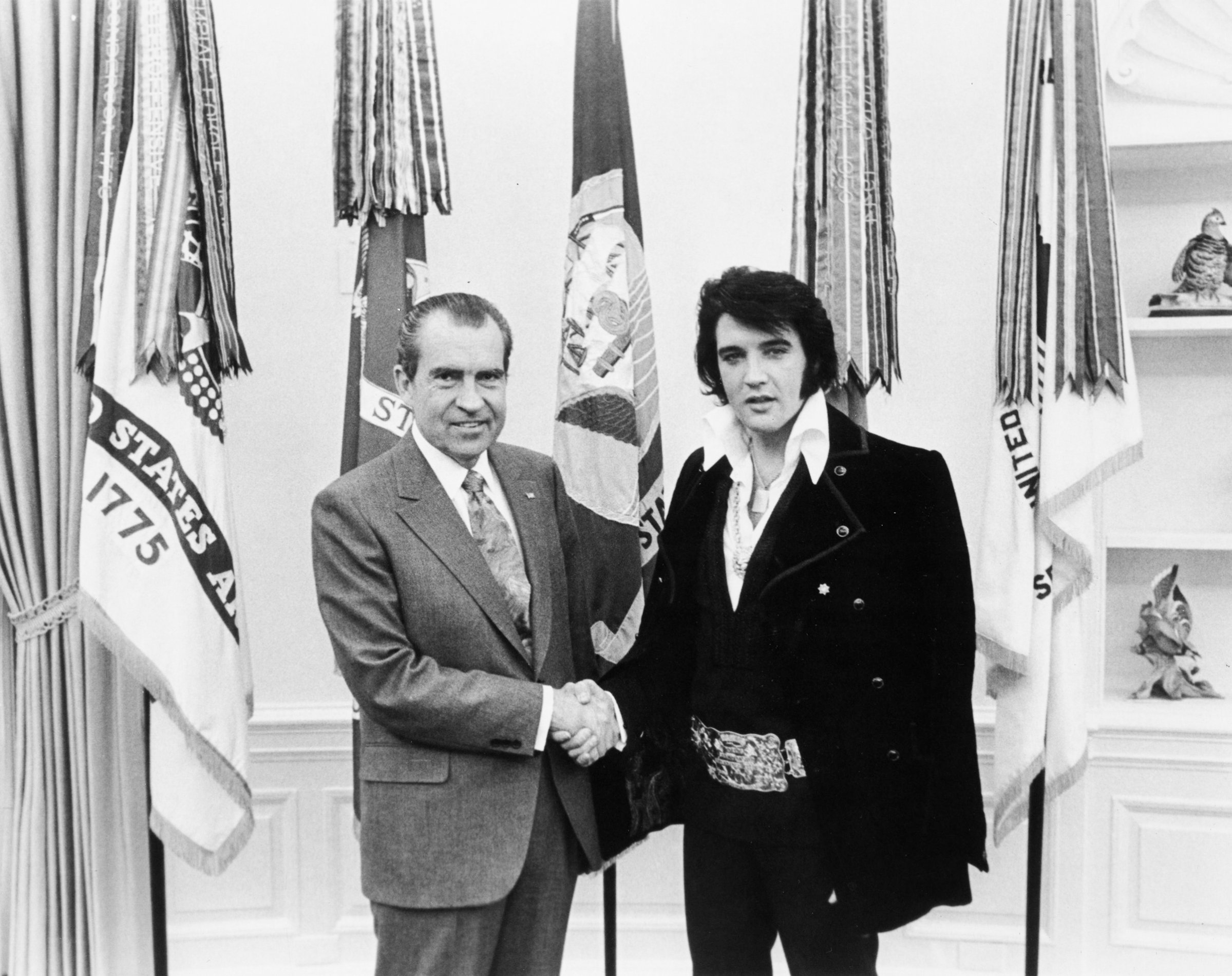
Though Elvis Presley’s music has largely been responsible for sustaining fans’ burning love for the 40 years that have passed since his Aug. 16, 1977, death, one of the most popular photos of the star is not an image of him performing.
Instead, it was taken with Richard Nixon in the Oval Office at 12:30 p.m. on Dec. 21, 1970 — and it was, as of 2015 at least, the most-requested photograph in the entire U.S. National Archives.
Both men were at the top in their careers at this point. As The Telegraph has pointed out, Presley was in the middle of a successful comeback, selling out shows in Las Vegas and had just been nominated as one of the country’s Ten Outstanding Young Men by the United States Junior Chamber, an award he was particularly proud to have received. Nixon, meanwhile, who had not yet been tainted by Watergate, was experiencing a wave of popularity for vowing to get America out of Vietnam and to desegregate schools.
But why did the King want to meet the President?
When Presley had showed up that morning at the White House — decked out in a purple velvet suit, a gold belt and a Colt. 45 pistol — he came bearing a personal letter to the President explaining his reasons. “I have done an in-depth study of drug abuse and Communist brainwashing techniques and I am right in the middle of the whole thing where I can and will do the most good,” the 35-year-old singer wrote in the letter, which noted that young people see him as one of them, thus making him the perfect person to help fight the war on illegal drugs. “I would love to meet you just to say hello if you’re not too busy.”
Presley, a collector of police badges, wanted a badge from the Bureau of Narcotics and Dangerous Drugs and to be named a “Federal Agent at Large.”
“The narc badge represented some kind of ultimate power to him,” Priscilla Presley, Elvis’ then-wife, wrote in her memoir Elvis and Me. “With the federal narcotics badge, he [believed he] could legally enter any country both wearing guns and carrying any drugs he wished.”
The fact that there was no transcript of the meeting has left much to the imagination (as explored most recently in the 2016 film Elvis & Nixon, starring Kevin Spacey as Nixon and Michael Shannon as Elvis.) What is known about what happened in the meeting comes from a memo that an aide who was in the room, Egil “Bud” Krogh, wrote up:
The President mentioned that he thought Presley could reach young people, and that it was important for Presley to retain his credibility. Presley responded that be [sic] did his thing by “just singing.” He said that he could not get to the kids if he made a speech on the stage, that he had to reach them in his own way. The President nodded in agreement.
Presley indicated that he thought the Beatles had been a real force for anti-American spirit. He said that the Beatles came to this country, made their money, and then returned to England where they promoted an anti-American theme. The President nodded in agreement and expressed some surprise. The President then indicated that those who use drugs are also those in the vanguard of anti-American protest. Violence, drug usage, dissent, protest all seem to merge in generally the same group of young people.
Presley indicated to the President in a very emotional manner that he was “on your side.” Presley kept repeating that he wanted to be helpful, that he wanted to restore some respect for the flag which was being lost. He mentioned that he was just a poor boy from Tennessee who had gotten a lot from his country, which in some way he wanted to repay. He also mentioned that he is studying Communist brainwashing and the drug culture for over ten years. He mentioned that he knew a lot about this and was accepted by the hippies. He said he could go right into a group of young people or hippies and be accepted which he felt could be helpful to him in his drug drive. The President indicated again his concern that Presley retain his credibility.
At the conclusion of the meeting, Presley again told the President how much he supported him, and then, in a surprising, spontaneous gesture, put his left arm around the President and hugged him.
The badge, aides later wrote, was an “honorary” one, but Elvis thought it was the real thing.
Both men would face swift falls from grace in the mid-1970s, between Nixon resigning in 1974 and Presley’s reliance on prescription drugs — which, a former employee later explained, he saw as separate from the illegal drugs he was so eager to help police — worsening in the lead-up to the heart attack that ultimately killed him. But the photograph would live on, as Nixon might have put it, in the nation’s collection of special mementos.
More Must-Reads From TIME
- The 100 Most Influential People of 2024
- Coco Gauff Is Playing for Herself Now
- Scenes From Pro-Palestinian Encampments Across U.S. Universities
- 6 Compliments That Land Every Time
- If You're Dating Right Now , You're Brave: Column
- The AI That Could Heal a Divided Internet
- Fallout Is a Brilliant Model for the Future of Video Game Adaptations
- Want Weekly Recs on What to Watch, Read, and More? Sign Up for Worth Your Time
Write to Olivia B. Waxman at olivia.waxman@time.com